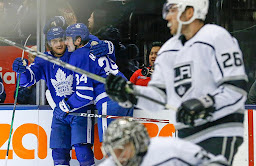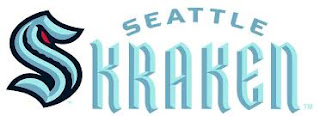So incredibly close. So vastly different.
The Toronto Maple Leafs and Columbus Blue Jackets awake Thursday as would-be Round 1 opponents under the NHL’s proposed
(but not yet approved) 24-team playoff format, and the matchup pits two
clubs operating with opposite styles but similar results.
Toronto (36-25-9) and Columbus (33-22-15) both finished an incomplete
2019-20 regular season with 81 points and a .579 points percentage.
They also split their head-to-head games with one win apiece, but both
of those tilts were held way back in October — when jogging pants and
band T-shirts were a treat, not my work uniform.
They both battled through tumultuous campaigns ravaged by injuries to
key players, and both had frights with unstable goaltending that
appeared to be sorted out by the pause.
That, however, is where the similarities end and the differences
begin in what is arguably the most compelling of the eight proposed
play-in brackets.
Why the Maple Leafs would totally win the series
Goals, goals and more goals.
How’s this for a stat? The Maple Leafs have four stars with a minimum of 59 points. The highest-scoring Blue Jacket, Pierre-Luc Dubois, is stuck at 49.
The Leafs wield the third-best offence in the league, while
Columbus’s is the fourth worst overall and the least frightening of all
24 teams that will be invited back to play. Toronto also boasts one of
the best power plays in hockey, at 23.1 per cent; Columbus’s 16.4 per
cent power play is the least effective of all 12 Eastern Conference
teams standing.
There is no wondering about identity here. This is a classic offence-versus-defence showdown.
And Toronto’s firepower will only be jolted by the healthy returns of
Morgan Rielly, Jake Muzzin and Ilya Mikheyev. (Winger Andreas Johnsson
will not be ready to play this summer.)
“Everyone is going to be sloppy,” said Brad Marchand, whose Bruins
could face the winner of this series. “I honestly think the teams that
are going to come back and look good are the really young teams, teams
like Toronto or Tampa, really high-end skilled teams.”
Besides offensive skill, the other advantage the Leafs should have is
in net. Columbus goaltenders Joonas Korpisalo and Elvis Merzlikins each
enjoyed breakout seasons and earned juicy pay raises as a result, but
that tandem has a combined zero games of NHL playoff experience.
Meanwhile, a happy and rested Frederik Andersen has zero load-management worries.
“I’m pretty open to pretty much anything that could be done to
salvage the season, finish the season and get a Stanley Cup champion,”
Andersen said.
Why the Blue Jackets would totally win the series
They’re finally (mostly) healthy, and they will structure and grind you to death.
Who cares if the Blue Jackets only had a 27.6 per cent chance of
making the post-season on March 12 (to the Leafs’ 78 per cent chance)?
That was the old reality.
The new reality is No. 1 defenceman Seth Jones healthy and eager, top
goal scorer Oliver Bjorkstrand fully recovered from his March 3 ankle
surgery and back skating, Cam Atkinson ready to roll, and possibly Josh
Anderson, too. (Anderson was given a rehab timeline of four to six
months after undergoing shoulder surgery March 2.)
In addition to rolling out the league’s fourth-stingiest defence and a
better penalty-killing unit than Toronto’s, the Blue Jackets are built
and conditioned to play a traditional playoff brand of hockey.
Block shots. Churn away relentlessly below the dots. Finish checks.
Squeak out wins in low-scoring affairs. Just ask the 2019 Presidents’
Trophy–winning Tampa Bay Lightning.
With Sheldon Keefe still unproven, we’ll also give Columbus the edge
behind the bench. Stanley Cup ring aside, few coaches milked more out of
less in 2019-20 than John Tortorella, with his roster ravaged by free
agency and injuries, and his goalies still feeling their way into the
NHL spotlight.So incredibly close. So vastly different.
The Toronto Maple Leafs and Columbus Blue Jackets awake Thursday as would-be Round 1 opponents under the NHL’s proposed
(but not yet approved) 24-team playoff format, and the matchup pits two
clubs operating with opposite styles but similar results.
Toronto (36-25-9) and Columbus (33-22-15) both finished an incomplete
2019-20 regular season with 81 points and a .579 points percentage.
They also split their head-to-head games with one win apiece, but both
of those tilts were held way back in October — when jogging pants and
band T-shirts were a treat, not my work uniform.
They both battled through tumultuous campaigns ravaged by injuries to
key players, and both had frights with unstable goaltending that
appeared to be sorted out by the pause.
That, however, is where the similarities end and the differences
begin in what is arguably the most compelling of the eight proposed
play-in brackets.
Why the Maple Leafs would totally win the series
Goals, goals and more goals.
How’s this for a stat? The Maple Leafs have four stars with a minimum of 59 points. The highest-scoring Blue Jacket, Pierre-Luc Dubois, is stuck at 49.
The Leafs wield the third-best offence in the league, while
Columbus’s is the fourth worst overall and the least frightening of all
24 teams that will be invited back to play. Toronto also boasts one of
the best power plays in hockey, at 23.1 per cent; Columbus’s 16.4 per
cent power play is the least effective of all 12 Eastern Conference
teams standing.
There is no wondering about identity here. This is a classic offence-versus-defence showdown.
And Toronto’s firepower will only be jolted by the healthy returns of
Morgan Rielly, Jake Muzzin and Ilya Mikheyev. (Winger Andreas Johnsson
will not be ready to play this summer.)
“Everyone is going to be sloppy,” said Brad Marchand, whose Bruins
could face the winner of this series. “I honestly think the teams that
are going to come back and look good are the really young teams, teams
like Toronto or Tampa, really high-end skilled teams.”
Besides offensive skill, the other advantage the Leafs should have is
in net. Columbus goaltenders Joonas Korpisalo and Elvis Merzlikins each
enjoyed breakout seasons and earned juicy pay raises as a result, but
that tandem has a combined zero games of NHL playoff experience.
Meanwhile, a happy and rested Frederik Andersen has zero load-management worries.
“I’m pretty open to pretty much anything that could be done to
salvage the season, finish the season and get a Stanley Cup champion,”
Andersen said.
Why the Blue Jackets would totally win the series
They’re finally (mostly) healthy, and they will structure and grind you to death.
Who cares if the Blue Jackets only had a 27.6 per cent chance of
making the post-season on March 12 (to the Leafs’ 78 per cent chance)?
That was the old reality.
The new reality is No. 1 defenceman Seth Jones healthy and eager, top
goal scorer Oliver Bjorkstrand fully recovered from his March 3 ankle
surgery and back skating, Cam Atkinson ready to roll, and possibly Josh
Anderson, too. (Anderson was given a rehab timeline of four to six
months after undergoing shoulder surgery March 2.)
In addition to rolling out the league’s fourth-stingiest defence and a
better penalty-killing unit than Toronto’s, the Blue Jackets are built
and conditioned to play a traditional playoff brand of hockey.
Block shots. Churn away relentlessly below the dots. Finish checks.
Squeak out wins in low-scoring affairs. Just ask the 2019 Presidents’
Trophy–winning Tampa Bay Lightning.
With Sheldon Keefe still unproven, we’ll also give Columbus the edge
behind the bench. Stanley Cup ring aside, few coaches milked more out of
less in 2019-20 than John Tortorella, with his roster ravaged by free
agency and injuries, and his goalies still feeling their way into the
NHL spotlight.
Further, since their Round 1 upset last spring, Columbus now has the
mental edge of knowing it can knock off a team that looks more talented
on paper. The Jackets love being the scrappy underdog with nothing to
lose. Between the ears, the pressure will be much greater on Toronto.
“[We’re] really focused on being above the puck, winning our battles, having good roles,” Jones said.
“If we’re all healthy hopefully we can just bring that to another level, surprise people again.”
My pick
The Blue Jackets would push this thing to the limit, but offence and
skill wins out. The Maple Leafs survive in five, win their first playoff
series in more than 16 years… and only have four more rounds to go.


































